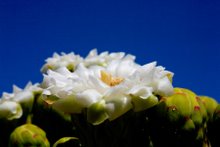
Castle Hot Springs Rd is a gem of a drive just north of the Phoenix Metro area off of the Carefree Highway, SR 74. The road butts up against the
Hells Canyon Wilderness, 9,900 acres of pristine desert wilderness.

The road was originally created to service the
Castle Hot Springs resort, which opened in 1896 and stayed in operation until a fire closed it down in 1976. Several presidents and famous individuals spent time at the resort, including Presidents Theodore Roosevelt, Warren Harding, Woodrow Wilson and Herbert Hoover. John F. Kennedy spent three months at the resort in 1945, recovering from wounds received in World War II as a Naval officer. Clark Gable and Carole Lombard also spent their honeymoon at the resort.

Castle Hot Springs got its name and reputation from the year-round hot springs that flow from the castle-like stone walls in the area. The water temperature hovers between 115 and 122 degrees. The resort still stands and is undergoing renovation, however it is private property that should be respected.

Today the road is about 28 miles of well maintained graded dirt road that makes for a very easy and leisurely drive in dry conditions (I was able to enjoy this trip in a minivan). The road is currently maintained to accommodate the needs of ranching and mining in the area, and it passes through several stretches of private land, so be aware when exploring. There are several abandoned corrals, hiking trails, and washes throughout the drive that afford many opportunities to stretch your legs and get out the camera. Wildlife is plentiful for birding and wildlife photography, the plant diversity is fantastic, especially in the spring when the wildflowers and cacti are in bloom, and there are gorgeous mountains in all directions for fantastic landscape photography opportunities. Any photographer could occupy themselves for hours here.

Castle Hot Springs Road starts heading north off of highway 74 around mile marker 121, just a couple miles east of US 60. The road turns to dirt after just a few miles, and the road should not be taken during or after heavy rain since much of the road runs through washes that could easily flood.
Following the road through to its end will bring you past Lake Pleasant and back to highway 74. If you leave early you can spend much of the day relaxing near
Lake Pleasant, which has great fishing and boating, as well as numerous hiking and off road trails. From 74 it is only about 11 miles east to I-17.












